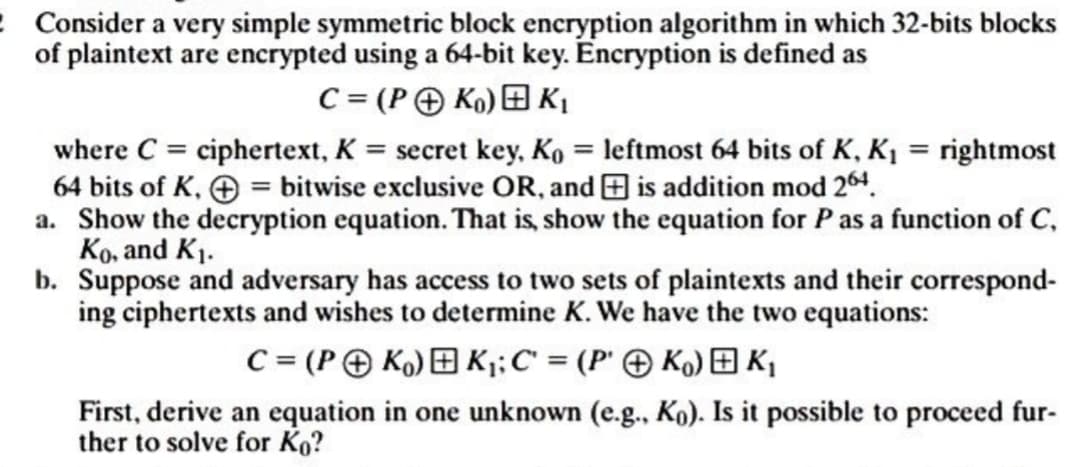Consider a very simple symmetric block encryption algorithm in which 32-bits blocks of plaintext are encrypted using a 64-bit key. Encryption is defined as C = (P + Ko) K₁ where C = ciphertext, K = secret key, Ko = leftmost 64 bits of K, K₁ = rightmost 64 bits of K. = bitwise exclusive OR, and is addition mod 264. a. Show the decryption equation. That is, show the equation for P as a function of C, Ko, and K₁. b. Suppose and adversary has access to two sets of plaintexts and their correspond- ing ciphertexts and wishes to determine K. We have the two equations: C = (PK) K₁; C = (PK) K₁ First, derive an equation in one unknown (e.g., Ko). Is it possible to proceed fur- ther to solve for Ko?
Consider a very simple symmetric block encryption algorithm in which 32-bits blocks of plaintext are encrypted using a 64-bit key. Encryption is defined as C = (P + Ko) K₁ where C = ciphertext, K = secret key, Ko = leftmost 64 bits of K, K₁ = rightmost 64 bits of K. = bitwise exclusive OR, and is addition mod 264. a. Show the decryption equation. That is, show the equation for P as a function of C, Ko, and K₁. b. Suppose and adversary has access to two sets of plaintexts and their correspond- ing ciphertexts and wishes to determine K. We have the two equations: C = (PK) K₁; C = (PK) K₁ First, derive an equation in one unknown (e.g., Ko). Is it possible to proceed fur- ther to solve for Ko?
Database System Concepts
7th Edition
ISBN:9780078022159
Author:Abraham Silberschatz Professor, Henry F. Korth, S. Sudarshan
Publisher:Abraham Silberschatz Professor, Henry F. Korth, S. Sudarshan
Chapter1: Introduction
Section: Chapter Questions
Problem 1PE
Related questions
Question

Transcribed Image Text:2 Consider a very simple symmetric block encryption algorithm in which 32-bits blocks
of plaintext are encrypted using a 64-bit key. Encryption is defined as
C = (PK₁) K₁
where C = ciphertext, K = secret key, Ko = leftmost 64 bits of K, K₁= rightmost
64 bits of K, = bitwise exclusive OR, and is addition mod 264.
a. Show the decryption equation. That is, show the equation for P as a function of C,
Ko, and K₁.
b. Suppose and adversary has access to two sets of plaintexts and their correspond-
ing ciphertexts and wishes to determine K. We have the two equations:
C = (PK) K₁; C = (PK) K₁
First, derive an equation in one unknown (e.g., Ko). Is it possible to proceed fur-
ther to solve for Ko?
Expert Solution
This question has been solved!
Explore an expertly crafted, step-by-step solution for a thorough understanding of key concepts.
This is a popular solution!
Trending now
This is a popular solution!
Step by step
Solved in 2 steps with 1 images

Knowledge Booster
Learn more about
Need a deep-dive on the concept behind this application? Look no further. Learn more about this topic, computer-science and related others by exploring similar questions and additional content below.Recommended textbooks for you

Database System Concepts
Computer Science
ISBN:
9780078022159
Author:
Abraham Silberschatz Professor, Henry F. Korth, S. Sudarshan
Publisher:
McGraw-Hill Education

Starting Out with Python (4th Edition)
Computer Science
ISBN:
9780134444321
Author:
Tony Gaddis
Publisher:
PEARSON

Digital Fundamentals (11th Edition)
Computer Science
ISBN:
9780132737968
Author:
Thomas L. Floyd
Publisher:
PEARSON

Database System Concepts
Computer Science
ISBN:
9780078022159
Author:
Abraham Silberschatz Professor, Henry F. Korth, S. Sudarshan
Publisher:
McGraw-Hill Education

Starting Out with Python (4th Edition)
Computer Science
ISBN:
9780134444321
Author:
Tony Gaddis
Publisher:
PEARSON

Digital Fundamentals (11th Edition)
Computer Science
ISBN:
9780132737968
Author:
Thomas L. Floyd
Publisher:
PEARSON

C How to Program (8th Edition)
Computer Science
ISBN:
9780133976892
Author:
Paul J. Deitel, Harvey Deitel
Publisher:
PEARSON

Database Systems: Design, Implementation, & Manag…
Computer Science
ISBN:
9781337627900
Author:
Carlos Coronel, Steven Morris
Publisher:
Cengage Learning

Programmable Logic Controllers
Computer Science
ISBN:
9780073373843
Author:
Frank D. Petruzella
Publisher:
McGraw-Hill Education